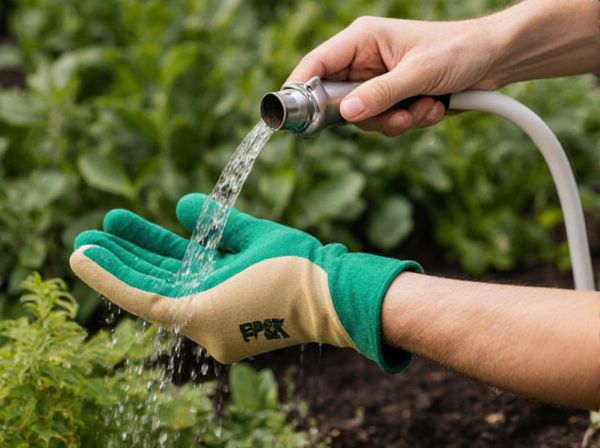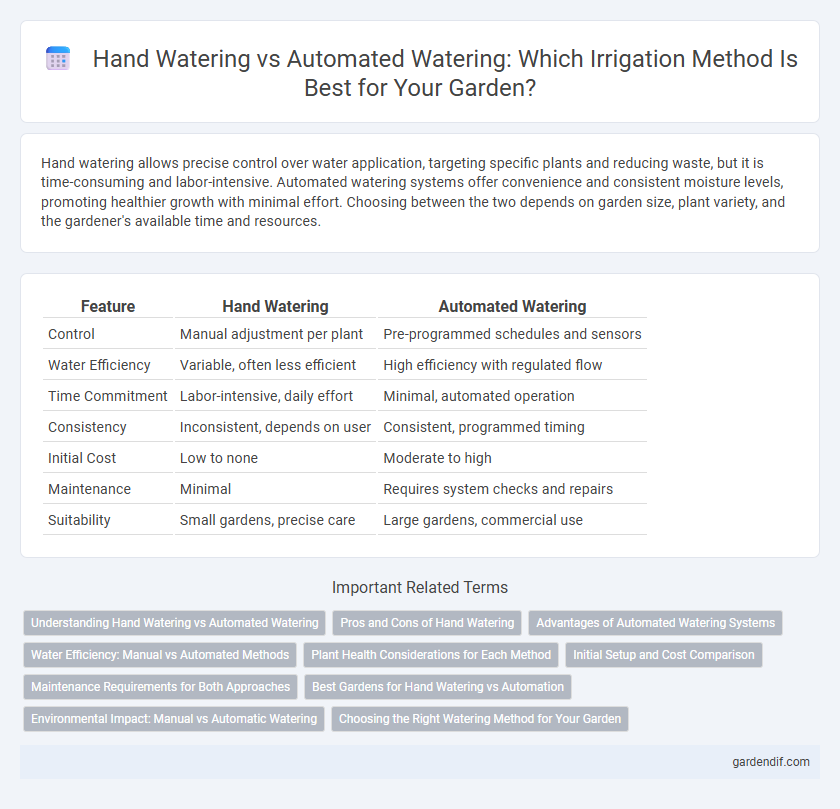
Hand watering vs Automated watering Illustration
Hand watering allows precise control over water application, targeting specific plants and reducing waste, but it is time-consuming and labor-intensive. Automated watering systems offer convenience and consistent moisture levels, promoting healthier growth with minimal effort. Choosing between the two depends on garden size, plant variety, and the gardener's available time and resources.
Table of Comparison
| Feature | Hand Watering | Automated Watering |
|---|---|---|
| Control | Manual adjustment per plant | Pre-programmed schedules and sensors |
| Water Efficiency | Variable, often less efficient | High efficiency with regulated flow |
| Time Commitment | Labor-intensive, daily effort | Minimal, automated operation |
| Consistency | Inconsistent, depends on user | Consistent, programmed timing |
| Initial Cost | Low to none | Moderate to high |
| Maintenance | Minimal | Requires system checks and repairs |
| Suitability | Small gardens, precise care | Large gardens, commercial use |
Understanding Hand Watering vs Automated Watering
Hand watering provides precise control over the amount and timing of water applied, making it ideal for delicate plants and specific garden areas. Automated watering systems offer consistent, efficient irrigation with programmable schedules, reducing water waste and labor. Understanding the differences helps gardeners choose the best method based on plant needs, garden size, and water conservation goals.
Pros and Cons of Hand Watering
Hand watering offers precise control over the amount of water delivered, reducing waste and catering to specific plant needs, but it can be time-consuming and labor-intensive for large gardens. This method allows gardeners to inspect plants closely for signs of disease or pests, promoting healthier growth. However, inconsistent watering schedules and human error may lead to under- or over-watering, affecting plant health and growth.
Advantages of Automated Watering Systems
Automated watering systems provide precise water delivery, minimizing waste and promoting optimal plant growth through consistent moisture levels. These systems can be programmed to operate at ideal times, adapting to weather conditions and reducing labor compared to manual hand watering. Enhanced efficiency and time-saving benefits make automated watering an environmentally friendly and cost-effective solution for maintaining healthy gardens and landscapes.
Water Efficiency: Manual vs Automated Methods
Manual hand watering allows precise control over water usage, reducing waste by targeting specific plants and soil areas. Automated watering systems optimize efficiency through timers and moisture sensors, delivering consistent amounts based on real-time data to prevent over- or under-watering. Overall, automation enhances water conservation by minimizing evaporation and runoff compared to manual methods, especially in larger gardens or commercial settings.
Plant Health Considerations for Each Method
Hand watering allows precise control over water delivery, reducing the risk of overwatering and promoting healthy root development by targeting the soil directly. Automated watering systems ensure consistent moisture levels, preventing drought stress but may lead to shallow root growth or fungal diseases if not properly calibrated. Selecting the appropriate method depends on plant species, soil type, and environmental conditions to optimize hydration and overall plant health.
Initial Setup and Cost Comparison
Hand watering requires minimal initial setup, primarily involving a hose or watering can, resulting in low upfront costs. Automated watering systems demand a higher initial investment for components like timers, valves, and irrigation tubing, but these systems can offer long-term savings by optimizing water use. Cost comparison shows hand watering is cheaper initially, while automated watering incurs higher startup costs offset by efficiency and labor savings over time.
Maintenance Requirements for Both Approaches
Hand watering requires regular attention to monitor soil moisture and adjust watering frequency, leading to higher time investment and potential inconsistency. Automated watering systems need periodic maintenance such as checking for clogs, leaks, and timer calibration to ensure efficient operation. Both methods demand routine upkeep, but automation can reduce manual labor while requiring technical upkeep to prevent system failures.
Best Gardens for Hand Watering vs Automation
Hand watering offers precise control ideal for delicate plants and small gardens, ensuring targeted hydration and reduced water waste. Automated watering systems excel in large or complex gardens by providing consistent, scheduled irrigation that promotes healthy growth and conserves water. Best gardens for hand watering include intricate flower beds or container plants, while expansive lawns or vegetable gardens benefit most from automated solutions.
Environmental Impact: Manual vs Automatic Watering
Hand watering typically consumes more water due to less precise application and the tendency to overwater, increasing environmental strain. Automated watering systems use sensors and timers to deliver water efficiently, reducing waste and promoting healthier plant growth. Studies show automated watering can cut water use by up to 30%, significantly lowering the ecological footprint compared to manual methods.
Choosing the Right Watering Method for Your Garden
Hand watering offers precise control over water distribution, making it ideal for delicate plants or small garden areas where specific attention is needed. Automated watering systems, such as drip irrigation or sprinkler timers, provide consistent moisture levels and conserve water by reducing evaporation and runoff, suitable for larger gardens or busy schedules. Selecting the right method depends on garden size, plant types, water availability, and convenience preferences.
Hand watering vs Automated watering Infographic

 gardendif.com
gardendif.com